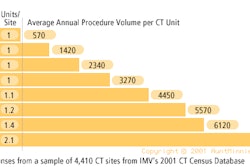CHICAGO - A range of scan parameters for multislice CT can result in a large variation in radiation doses, according to a study presented Sunday at the annual RSNA meeting. In particular, technical parameters such as penumbra, may require more aggressive modifications of multislice scanning parameters in order to maintain radiation doses in the range of those currently found with single slice helical scanners.
Previous to the findings presented Sunday, the differences in radiation dose between single slice CT and multislice CT remained unknown. "[Multislice] CT is a different technology than single-slice CT, particularly with respect to the type of beam," said Duke University presenter Dr. Donald P. Frush. "And the technique is different."
As CT provides the highest medical dose of radiation and the use of CT and multislice CT is increasing, Dr. Frush and colleagues decided to define the difference in radiation dose between technically similar single-slice and multislice body CT protocols.
To measure the difference in radiation dose between the two technologies, the researchers placed thermoluminescent detectors within the center of a 16cm phantom, which they then scanned over its entire length at a 21mm distance. Following these scans, the researchers compared the radiation dose produced for a range of abdomen protocols used to examine children between the ages of two and five, as stated in guidelines published earlier in 2001.
Although multislice and single-slice CT proved comparable for low-dose pediatric protocols (3.064mGy versus 2.127mGy), multislice scanning resulted in a 100 percent higher dose in the medium dose (19.387mGy versus 9.76mGy) and a 63 percent increase in the high dose (49.763mGy versus 30.484mGy).
Also, the researchers collected noise and contrast data in order to examine the effects of reduced dose on scan quality. To do so, the researchers used a concept called "the figure of merit," which examines the signal-to-noise ratio and dose in order to arrive at a quantitative calculation.
"What we found using this figure of merit was that the CTi (scanner) at the high dose gave the highest figure of merit, all the way down to the CTi at the medium dose, with the QXi (scanner) high and medium dose protocols being comparable in terms of this index of balancing scan quality and dose."
By Leslie Farnsworth
AuntMinnie.com contributing writer
November 25, 2001
For the rest of our coverage of the 2001 RSNA meeting, go to our RADCast@RSNA 2001.
Copyright © 2001 AuntMinnie.com




















